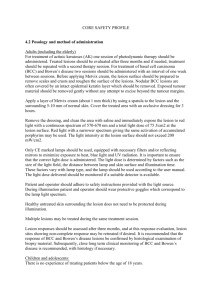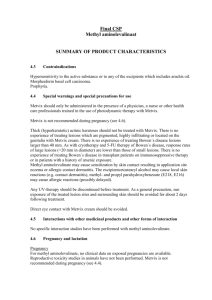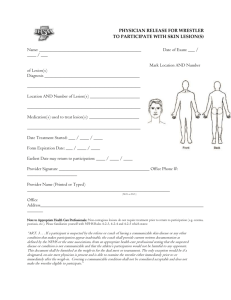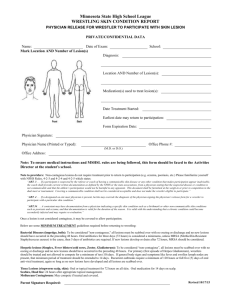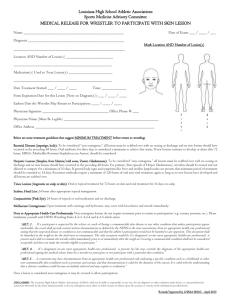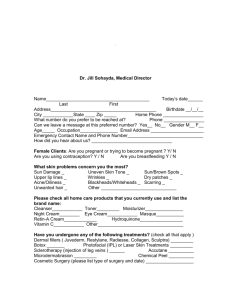Children and adolescents
advertisement
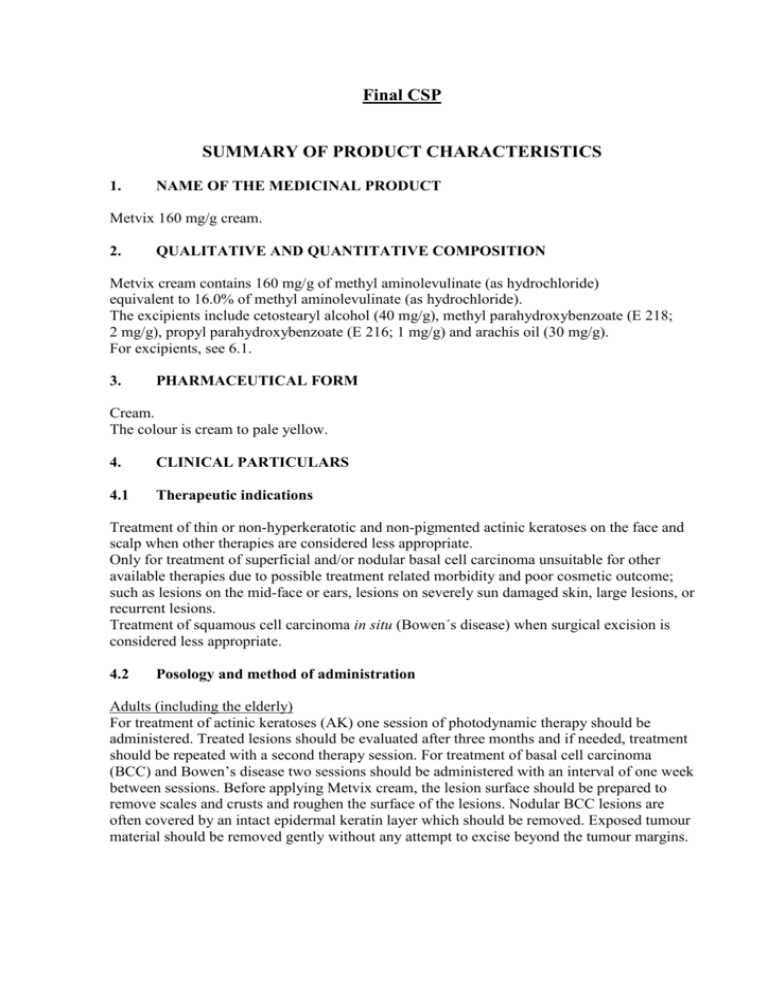
Final CSP SUMMARY OF PRODUCT CHARACTERISTICS 1. NAME OF THE MEDICINAL PRODUCT Metvix 160 mg/g cream. 2. QUALITATIVE AND QUANTITATIVE COMPOSITION Metvix cream contains 160 mg/g of methyl aminolevulinate (as hydrochloride) equivalent to 16.0% of methyl aminolevulinate (as hydrochloride). The excipients include cetostearyl alcohol (40 mg/g), methyl parahydroxybenzoate (E 218; 2 mg/g), propyl parahydroxybenzoate (E 216; 1 mg/g) and arachis oil (30 mg/g). For excipients, see 6.1. 3. PHARMACEUTICAL FORM Cream. The colour is cream to pale yellow. 4. CLINICAL PARTICULARS 4.1 Therapeutic indications Treatment of thin or non-hyperkeratotic and non-pigmented actinic keratoses on the face and scalp when other therapies are considered less appropriate. Only for treatment of superficial and/or nodular basal cell carcinoma unsuitable for other available therapies due to possible treatment related morbidity and poor cosmetic outcome; such as lesions on the mid-face or ears, lesions on severely sun damaged skin, large lesions, or recurrent lesions. Treatment of squamous cell carcinoma in situ (Bowen´s disease) when surgical excision is considered less appropriate. 4.2 Posology and method of administration Adults (including the elderly) For treatment of actinic keratoses (AK) one session of photodynamic therapy should be administered. Treated lesions should be evaluated after three months and if needed, treatment should be repeated with a second therapy session. For treatment of basal cell carcinoma (BCC) and Bowen’s disease two sessions should be administered with an interval of one week between sessions. Before applying Metvix cream, the lesion surface should be prepared to remove scales and crusts and roughen the surface of the lesions. Nodular BCC lesions are often covered by an intact epidermal keratin layer which should be removed. Exposed tumour material should be removed gently without any attempt to excise beyond the tumour margins. Apply a layer of Metvix cream (about 1 mm thick) by using a spatula to the lesion and the surrounding 5-10 mm of normal skin. Cover the treated area with an occlusive dressing for 3 hours. Remove the dressing, and clean the area with saline and immediately expose the lesion to red light with a continuous spectrum of 570-670 nm and a total light dose of 75 J/cm2 at the lesion surface. Red light with a narrower spectrum giving the same activation of accumulated porphyrins may be used. The light intensity at the lesion surface should not exceed 200 mW/cm2. Only CE marked lamps should be used, equipped with necessary filters and/or reflecting mirrors to minimize exposure to heat, blue light and UV radiation. It is important to ensure that the correct light dose is administered. The light dose is determined by factors such as the size of the light field, the distance between lamp and skin surface and illumination time. These factors vary with lamp type, and the lamp should be used according to the user manual. The light dose delivered should be monitored if a suitable detector is available. Patient and operator should adhere to safety instructions provided with the light source. During illumination patient and operator should wear protective goggles which correspond to the lamp light spectrum. Healthy untreated skin surrounding the lesion does not need to be protected during illumination. Multiple lesions may be treated during the same treatment session. Lesion responses should be assessed after three months, and at this response evaluation, lesion sites showing non-complete response may be retreated if desired. It is recommended that the response of BCC and Bowen’s disease lesions be confirmed by histological examination of biopsy material. Subsequently, close long term clinical monitoring of BCC and Bowen´s disease is recommended, with histology if necessary. Children and adolescents: There is no experience of treating patients below the age of 18 years. 4.3 Contraindications Hypersensitivity to the active substance or to any of the excipients which includes arachis oil. Morpheaform basal cell carcinoma. Porphyria. 4.4 Special warnings and special precautions for use Metvix should only be administered in the presence of a physician, a nurse or other health care professionals trained in the use of photodynamic therapy with Metvix. Metvix is not recommended during pregnancy (see 4.6). Thick (hyperkeratotic) actinic keratoses should not be treated with Metvix. There is no experience of treating lesions which are pigmented, highly infiltrating or located on the genitalia with Metvix cream. There is no experience of treating Bowen´s disease lesions larger than 40 mm. As with cryotherapy and 5-FU therapy of Bowen´s disease, response rates of large lesions (>20 mm in diameter) are lower than those of small lesions. There is no experience of treating Bowen´s disease in transplant patients on immunosuppressive therapy or in patients with a history of arsenic exposure. Methyl aminolevulinate may cause sensitization by skin contact resulting in application site eczema or allergic contact dermatitis. The excipientcetostearyl alcohol may cause local skin reactions (e.g. contact dermatitis), methyl- and propyl parahydroxybenzoate (E218, E216) may cause allergic reactions (possibly delayed). Any UV-therapy should be discontinued before treatment. As a general precaution, sun exposure of the treated lesion sites and surrounding skin should be avoided for about 2 days following treatment. Direct eye contact with Metvix cream should be avoided. 4.5 Interactions with other medicinal products and other forms of interaction No specific interaction studies have been performed with methyl aminolevulinate. 4.6 Pregnancy and lactation Pregnancy For methyl aminolevulinate, no clinical data on exposed pregnancies are available. Reproductive toxicity studies in animals have not been performed. Metvix is not recommended during pregnancy (see 4.4). Lactation The amount of methyl aminolevulinate excreted into human breast milk following topical administration of Metvix cream is not known. In the absence of clinical experience, breastfeeding should be discontinued for 48 hours after application of Metvix cream. 4.7 Effects on ability to drive and use machines Not applicable. 4.8 Undesirable effects a) Approximately 60 % of patients experience reactions localised to the treatment site that are attributable to toxic effects of the photodynamic therapy (phototoxicity) or to preparation of the lesion. The most frequent symptoms are painful and burning skin sensation typically beginning during illumination or soon after and lasting for a few hours with resolving on the day of treatment. The symptoms are usually of mild or moderate severity and rarely require early termination of illumination. The most frequent signs of phototoxicity are erythema and scab. The majority are of mild or moderate severity and persist for 1 to 2 weeks or occasionally longer. Repeated treatment with Metvix is associated reduced frequency and severity of local phototoxic reactions. b) The incidence of adverse reactions in a clinical trial population of 932 patients receiving the standard treatment regimen, is shown in the table below. Body system (MedDRA) Frequency* Nervous system disorders Eye disorders Vascular disorders Gastrointestinal disorders Skin and subcutaneous tissue disorders Common Uncommon Uncommon Uncommon Very common Adverse reaction Paraesthesia, headache Eye swelling, eye pain Wound haemorrhage Nausea Pain of skin, skin burning sensation, scab, erythema Common Skin infection, skin ulcer, skin oedema, skin swelling, blister, skin hemorrhage, pruritus, skin exfoliation, skin warm Uncommon Urticaria, rash, skin irritation, photosensitivity reaction, skin hypopigmentation, skin hyperpigmentation, heat rash, skin discomfort General disorders and Common Application site discharge, feeling hot administration site conditions Uncommon Fatigue * Very common adverse reactions: Adverse reactions occurring in 1/10) of patients. Common adverse reactions: Adverse reactions occurring in 1/100, <1/10 of patients. Uncommon adverse reactions: Adverse reactions occurring in 1/1000, 1/100 of patients. Adverse reactions reported by more than two patients in the clinical studies are included. Application site eczema and allergic contact dermatitis have been described in post-marketing reports. Most cases were localised to the treatment area and were not severe; rarely erythema and swelling have been more extensive. A study conducted in immunocompromised organ transplant recipients did not identify any safety concern in this population, adverse events being similar to those reported in trials in immunocompetent patients. 4.9 Overdose The severity of local phototoxic reactions such as erythema, pain and burning sensation may increase in case of prolonged application time or very high light intensity. 5. PHARMACOLOGICAL PROPERTIES 5.1 Pharmacodynamic properties Pharmacotherapeutic group: Antineoplastic agent, ATC Code: L01X D03 Mechanism of Action: After topical application of methyl aminolevulinate, porphyrins accumulate intracellularly in the treated skin lesions. The intracellular porphyrins (including PpIX) are photoactive, fluorescing compounds and, upon light activation in the presence of oxygen, singlet oxygen is formed which causes damage to cellular compartments, in particular the mitochonidria. Light activation of accumulated porphyrins leads to a photochemical reaction and thereby phototoxicity to the light-exposed target cells. 5.2 Pharmacokinetic properties In vitro dermal absorption of radiolabelled methyl aminolevulinate applied to human skin has been studied. After 24 hours the mean cumulative absorption through human skin was 0.26 % of the administered dose. A skin depot containing 4.9 % of the dose was formed. No corresponding studies in human skin with damage similar to actinic keratosis lesions and additionally roughened surface or without stratum corneum were performed. In humans, a higher degree of accumulation of porphyrins in lesions compared to normal skin has been demonstrated with Metvix cream. After application of the cream for 3 hours and subsequent illumination with non-coherent light of 570-670 nm wavelength and a total light dose of 75 J/cm2, complete photobleaching occurs with levels of porphyrins returning to pretreatment values. 5.3 Preclinical safety data Preclinical studies on general toxicity and genotoxicity studies in the presence or absence of photoactivation, do not indicate potential risks for man. Carcinogenicity studies or studies on the reproductive function have not been performed with methyl aminolevulinate. 6. PHARMACEUTICAL PARTICULARS 6.1 List of excipients Self-emulsifying glyceryl monostearate cetostearyl alcohol poloxyl 40 stearate methyl parahydroxybenzoate (E 218) propyl parahydroxybenzoate (E 216) disodium edetate glycerol white soft paraffin cholesterol isopropyl myristate arachis oil refined almond oil oleyl alcohol purified water. 6.2 Incompatibilities Not applicable. 6.3 Shelf life Unopened: 18 months. 1 week after first opening of the container. 6.4 Special precautions for storage Store at 2 °C - 8 C (in a refrigerator). 6.5 Nature and contents of containers Aluminium tube with internal protective lacquer and a latex seal. Screw cap of HDPE. Metvix cream is supplied in a tube containing 2 g cream. 6.6 Special precautions for disposal No special requirements. 7. MARKETING AUTHORISATION HOLDER PhotoCure ASA Hoffsveien 48 NO-0377 Oslo Norway. 8. MARKETING AUTHORISATION NUMBER 16338 9. DATE OF FIRST AUTHORISATION/RENEWAL OF THE AUTHORISATION 2001-06-15 / 2006-06-15 10. DATE OF REVISION OF THE TEXT 2008-07-24-
